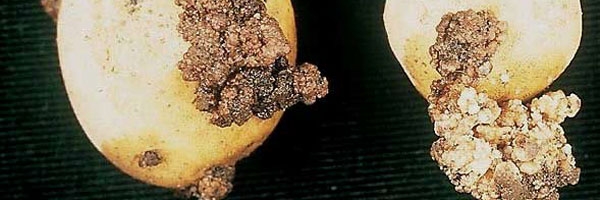
Synchytrium endobioticum
(Potato wart disease or Black wart)
- Causal agent and transmission
Potato wart is a serious disease, caused by a soil-borne fungus, Synchytrium endobioticum. It is an obligate parasite, which does not produce mycelium but an abundance of dissemination sporangia which are responsible for tumour formation on underground potato organs. These sporangia produce zoospores, organs of dissemination and infection.
This fungus can survive for many years (up to 30 years) in the soil in the form of a cyst (survival spores).
The primary infection may be caused by seed tubers, infected soil or by any plant for planting (flower bulb or nursery stocks) carrying infected soil.
Although potentially pathogenic to several Solanaceae (tomatoes, aubergines and weeds), it is mainly found in potatoes. In the case of seed production, strict quarantine measures must be taken.
- Significance
Potato wart disease may be a serious concern for potato production and is very difficult to eradicate once introduced in a field. Severe legislations are enforced to avoid its dissemination; in Europe, for example, this pathogen is a regulated pest and is classified as a quarantine organism (A2 list).
The variability of this severe pathogen is a major concern and takes the form of numerous pathotypes (over 20), characterised by their virulence towards various potato cultivars. Pathotype 1, identified in Germany and in the Netherlands, is predominant.
The disease is especially present in cold, humid climates, e.g. in Northern and Central Europe (Poland and the Czech Republic).





